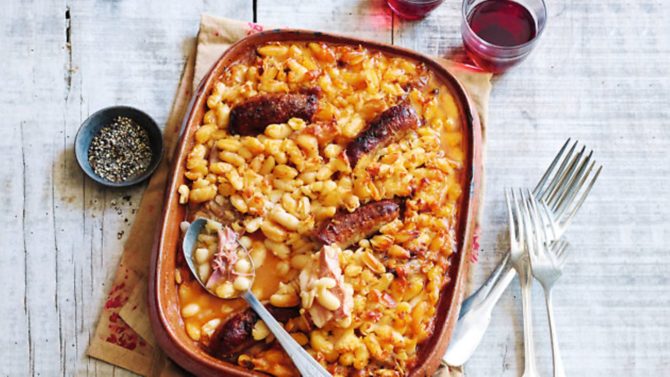Cassoulet recipe

Discover the history behind the French classic cassoulet and make your own cassoulet with Mary Cadogan’s easy recipe
Cassoulet is an iconic dish from south-west France consisting of slowly cooked white beans layered with sausage and meats, and traditionally baked in a terracotta dish called a ‘cassole’, from which it gets its name. The ingredients vary depending on where the dish originates. Cassoulet from Toulouse will contain Toulouse sausage of course, plus mutton or lamb as well as duck or goose confit. In Castelnaudary, you will find pork and duck confit. In the south of the area, tarbais beans will be used which are grown at the foot of the Pyrenees. In Castelnaudary it will always be lingot beans. More than perhaps any other dish, there is fierce debate throughout the region about which recipe is the most authentic. As Gascon chef André Daguin puts it: “Cassoulet is not really a recipe, it’s a way to argue among neighbouring villages of Gascony.” There is even a brotherhood, the Grande Confrérie du Cassoulet de Castelnaudary, to protect the quality and local pride in the dish.
Cassoulet is essentially a peasant dish and would have been cooked for hours in the hearth or bread oven in the residual heat after the bread had been baked. The beans form a crust on top which is broken several times during cooking to create a thick crust. Tradition states the crust should be broken seven times to achieve the perfect dish.
It is a perfect winter dish and one that encourages conviviality as it’s a generous sharing dish for the truly hungry. Set the dish in the centre of the table and allow everyone to dig in and discover the treats that hide just under the crusty surface. A glass of the local deep red Madiran wine is said to be the perfect accompaniment.
RECIPE
INGREDIENTS
• 400g lingots, tarbais or other dried white haricot beans
• 100g thick-cut unsmoked streaky bacon
• 2 confit duck legs
• 250g pork shoulder
• about 1 litre of good chicken stock, preferably home-made
• 1 tbsp tomato paste
• 2 branches of thyme
• 2 bay leaves
• 1 onion, quartered
• 2 carrots, halved
• 2 cloves of garlic, chopped
• 4 Toulouse sausages
METHOD
1 The day before, put the beans in a large bowl and cover generously with cold water. Leave overnight to soak.
2 Drain the beans and put them into a large pan. Add water to cover and bring to the boil. Boil for 5 minutes, then drain and return the beans to the pan. Add the stock to come at least 2cm above the level of the beans. Add the tomato paste, thyme and bay leaves, onion and carrot. Bring to the boil, then reduce the heat and simmer for about 1 hour until the beans are tender. Drain the beans, reserving the stock. Discard the herbs, onion and carrot.
3 Cut the streaky bacon into four pieces. Heat a little duck fat scraped from the legs in a large frying pan. Add the duck legs and fry until golden, then remove. Cut each leg in half. Add the bacon and fry until well browned; remove. Cut the pork into four pieces and fry as before; remove. Fry the sausages until browned on all sides; remove. Gently fry the garlic in the remaining fat and set aside.
4 Heat the oven to 160°C/140°C fan/ Gas 4. Take a large shallow baking dish, preferably earthenware. Tip in a third of the beans and add all the meat except the sausages. Season with salt and pepper, then cover with the remaining beans. Bury the sausages in the beans and pour over stock to just cover the beans. Drizzle with the reserved garlicky fat and season with salt and plenty of black pepper.
5 Bake the cassoulet for 1-1 ½ hours, checking 2-3 times, breaking the crusty top and adding more stock to stop it drying out. The cassoulet is ready when the top forms a brown crust. Serve with crusty bread and a crisp green salad.
Mary Cadogan is a renowned food writer and former food director of BBC Good Food magazine. She moved to France in 2005 with her husband Mick, where they run a table d’hôte from their home. www.marycadogan.comHow about finishing your meal with our recipe for a delicious mousse au chocolat?
Or maybe our recipe for tarte Tatin is more up your street?
Share to: Facebook Twitter LinkedIn Email


